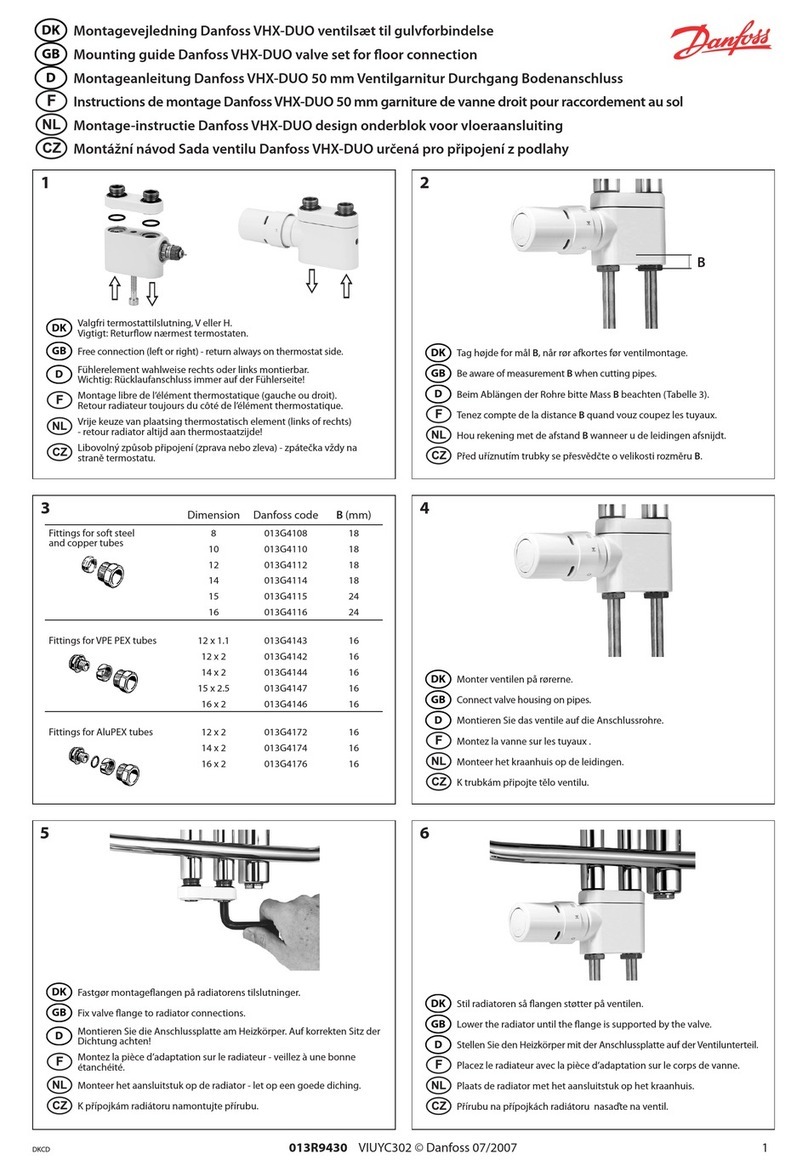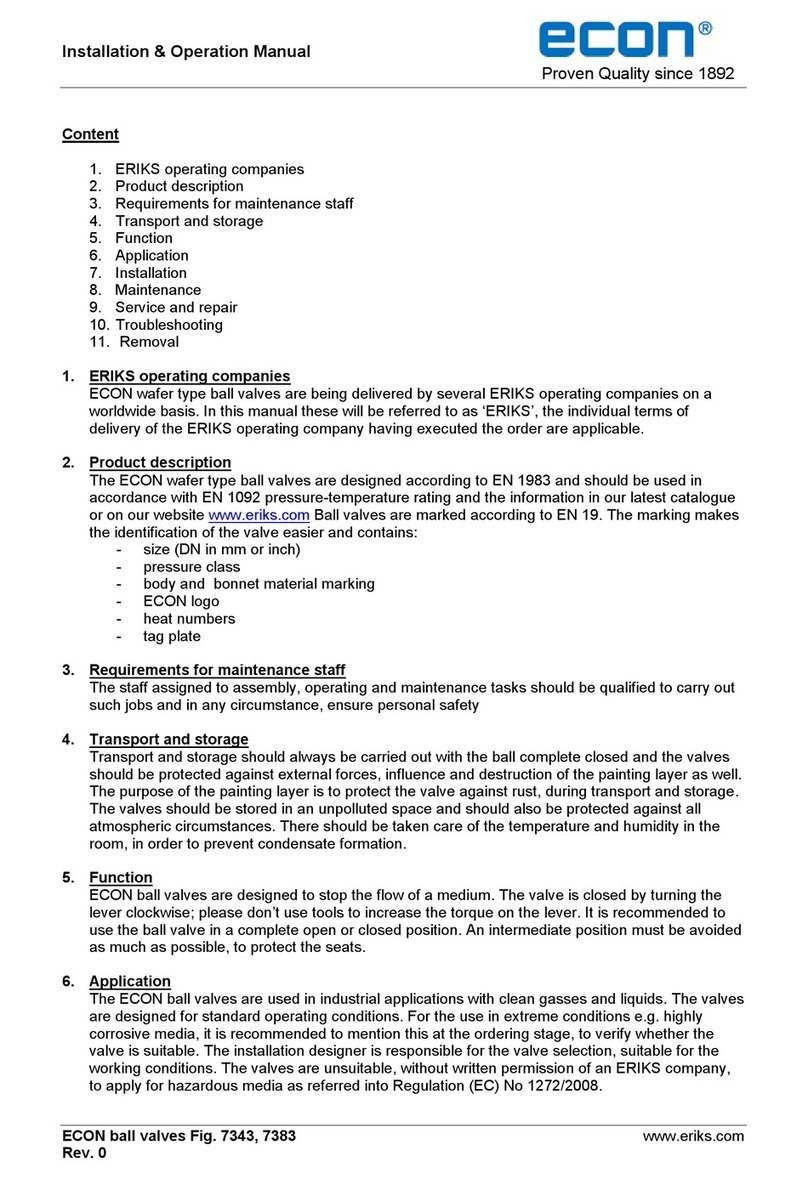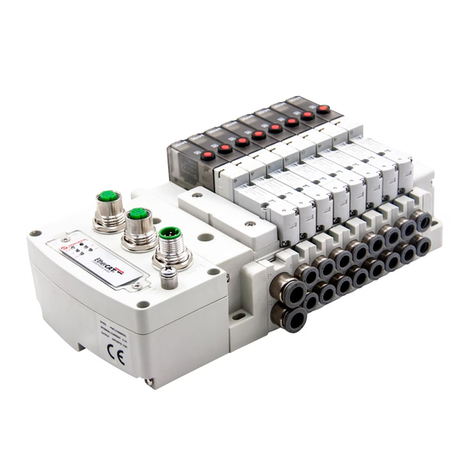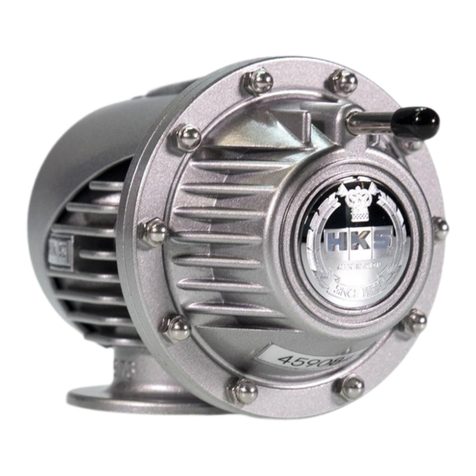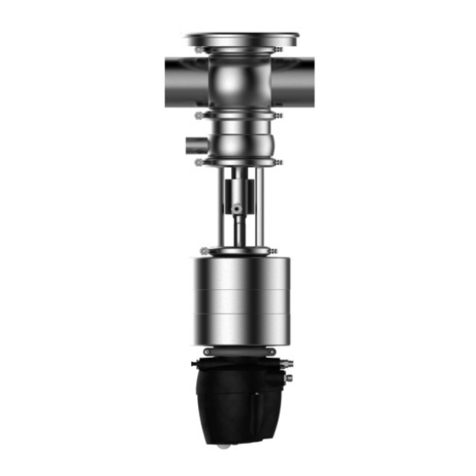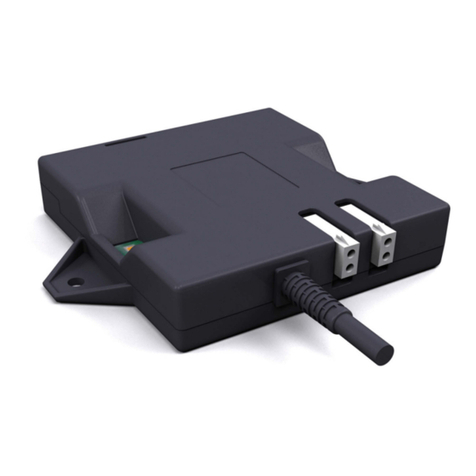EDI SmartMonitor MMU2-16LE Series User manual

THIS MANUAL CONTAINS TECHNICAL INFORMATION FOR THE MMU2-16LE and
MMU2-16LEip SmartMonitor®SERIES MALFUNCTION MANAGEMENT UNIT.
Firmware Version 7.4 (vXX74)
REVISION: NOVEMBER 2016
pn 888-2116-001
MMU2-16LE Series
SmartMonitor®
NEMA TS-2 MMU2 Enhanced
Malfunction Management Unit
Operations Manual
- NOTE -
EDI ECCOM SOFTWARE MUST BE UPDATED TO VERSION 4.1 OR
GREATER FOR COMPATIBILITY WITH THIS FIRMWARE VERSION.
THE ECCOM SOFTWARE IS AVAILABLE AT NO CHARGE AT
WWW.EDITRAFFIC.COM

.
THE MMU2-16LE SERIES IS DESIGNED AND MANUFACTURED IN THE USA BY
EBERLE DESIGN INC., PHOENIX, ARIZONA, AN ISO 9001:2015 REGISTERED
COMPANY.
INFORMATION CONTAINED HEREIN IS PROPRIETARY TECHNICAL
INFORMATION OF EBERLE DESIGN INC. PUBLICATION, REPRODUCTION OR
USE IN WHOLE OR PART IS NOT PERMITTED EXCEPT UNDER TERMS AGREED
UPON IN WRITING. © COPYRIGHT 2016 EDI.
Canadian Patent No. 2,574,101
U.S. Pat. No. 7,246,037
U.S. Pat. No. 9,460,620
MAINTENANCE NOTE
THIS EBERLE DESIGN INC. MALFUNCTION MANAGEMENT UNIT HAS BEEN
CAREFULLY INSPECTED AND TESTED TO ENSURE PROPER OPERATION. IT IS
RECOMMENDED THAT THE MALFUNCTION MANAGEMENT UNIT BE TESTED AT
LEAST ANNUALLY TO ENSURE PROPER OPERATION AND COMPLIANCE WITH
FACTORY SPECIFICATIONS.

.
Table of Contents
Section 1 General..............................................................................................................1
1.1 Description..............................................................................................................1
1.1.1 NEMA TS-2 MMU2 (FYA) Configuration ........................................................1
1.2 Advanced Feature Overview ...................................................................................1
1.2.1 Liquid Crystal Status and Field Display ..........................................................1
1.2.2 Menu Driven Operation ..................................................................................1
1.2.3 Context Sensitive Help System ......................................................................1
1.2.3.1 Set-up Wizard.......................................................................................2
1.2.3.2 Diagnostic Wizard.................................................................................2
1.2.4 Program Card Memory ..................................................................................2
1.2.4.1 MMU2 Program Card Memory Backward Compatibility ........................2
1.2.5 RMS Voltage Reporting .................................................................................2
1.2.6 ECcom Software Interface .............................................................................2
1.2.7 NEMA TS-1 Operation With SDLC Mode .......................................................3
1.2.8 Flashing Yellow Arrow (FYA) Protected-Permissive Movement......................3
1.3 General ...................................................................................................................3
1.4 Field Signal Terminals.............................................................................................4
1.4.1 LEDguard®LED Field Signal Sensing ............................................................5
1.4.2 Type Select Input...........................................................................................5
1.4.2.1 Type 12 With SDLC Mode ....................................................................5
1.4.2.2 Force Type 16 Mode.............................................................................6
Section 2 Standard Functions ..........................................................................................7
2.1 Conflict Monitoring ..................................................................................................7
2.2 Red Fail Monitoring .................................................................................................7
2.2.1 Red Enable Input ...........................................................................................7
2.2.2 Walk Disable Option ......................................................................................7
2.3 Voltage Monitoring ..................................................................................................8
2.3.1 +24Vdc Supply Monitoring .............................................................................8
2.3.1.1 +24Vdc Monitor Inhibit Input .................................................................8
2.3.1.2 +24Vdc Monitor Latch Input..................................................................8
2.3.1.3 +24Vdc Monitor II 12Vdc Mode.............................................................8
2.3.2 Controller Voltage / Fault Monitor Input..........................................................8
2.3.2.1 CVM Monitor Latch Input ......................................................................9
2.3.2.2 CVM Log Disable..................................................................................9
2.3.3 VM Monitor 3x/Day Latch...............................................................................9
2.4 Local Flash Status Input..........................................................................................9
2.5 Minimum Yellow Change / Red Clearance Monitoring .............................................9
2.5.1 Minimum Yellow Change Interval ...................................................................9
2.5.1.1 Minimum Yellow Clearance Disable....................................................10
2.5.1.2 Minimum Yellow Plus Red Interval......................................................10
2.5.1.3 Minimum Yellow Plus Red Clearance Disable.....................................10
2.6 MMU Power Failure Detection...............................................................................10
2.7 Port 1 Communications .........................................................................................11
2.7.1 Port 1 Timeout .............................................................................................11
2.7.2 Port 1 Disable Input .....................................................................................12
2.8 Type 129 Response Frame...................................................................................12
2.9 Output Relay Recovery .........................................................................................12
2.10 Internal Diagnostics.............................................................................................12
2.10.1 Memory Diagnostics ..................................................................................12
2.10.2 Microprocessor Monitor..............................................................................13
2.10.3 Internal Hardware Monitor..........................................................................13
Section 3 Enhanced Features.........................................................................................14
3.1 Hardware Features ...............................................................................................14
3.2 Dual Indication Monitoring.....................................................................................14
3.2.1 Walk Disable Option ....................................................................................15

.
3.3 External Watchdog Monitoring ..............................................................................15
3.4 Program Card Absent Indication ...........................................................................15
3.5 Reset Input Detection............................................................................................15
3.6 Display LED Test ..................................................................................................16
3.7 Recurrent Pulse Detection ....................................................................................16
3.8 Type Fault.............................................................................................................16
3.9 Field Check Monitoring..........................................................................................17
3.9.1 Field Check Fault.........................................................................................17
3.9.2 Field Check Status.......................................................................................17
3.10 Diagnostic Wizard ...............................................................................................18
3.11 MMU2 Flashing Yellow Arrow (FYA) Protected-Permissive Monitoring................19
3.11.1 MMU2 FYA Backward Compatibility...........................................................20
3.11.2 MMU2 FYA Configuration Modes (A – F) ...................................................20
3.11.2.1 Protected Turn Channel....................................................................20
3.11.2.2 Permissive Turn Channel..................................................................20
3.11.2.3 Opposing Through Channel ..............................................................20
3.11.2.4 MMU2 FYA Modes A, B, C, D...........................................................21
3.11.2.5 MMU2 FYA Modes E, F ....................................................................22
3.11.3 MMU2 FYA Configuration Modes (G - L)....................................................23
3.11.3.1 Protected Turn Channel....................................................................23
3.11.3.2 Permissive Turn Channel..................................................................23
3.11.3.3 Opposing Through Channel ..............................................................24
3.11.3.4 MMU2 FYA Alternate Modes G, H ....................................................24
3.11.3.5 MMU2 FYA Alternate Modes I, J.......................................................25
3.11.3.6 MMU2 FYA Alternate Modes K, L .....................................................25
3.11.4 Configuring the SmartMonitor Fault Parameters For FYA ..........................26
3.11.4.1 Conflict .............................................................................................26
3.11.4.2 Red Fail............................................................................................27
3.11.4.3 Dual Indication..................................................................................27
3.11.4.4 Minimum Yellow Clearance ..............................................................27
3.11.4.5 Yellow Plus Red Clearance ..............................................................27
3.11.5 Red and Yellow Input Enable .....................................................................28
3.11.5.1 Red and Green Input Disable (Modes G and H)................................28
3.11.6 Flash Rate Detection .................................................................................28
3.11.7 FYA Yellow Trap Conflict Detection ...........................................................28
Section 4 ECcom Interface .............................................................................................29
4.1 EDI ECcom Monitor Reports .................................................................................29
General Data ........................................................................................................29
Current Status (S).................................................................................................29
Previous Fault (PF) Event Log..............................................................................29
AC Line (AC) Event Log .......................................................................................29
Manual Reset (MR) Event Log..............................................................................30
Configuration (CF) Event Log ...............................................................................30
Signal Sequence Event Log..................................................................................30
4.2 Configuration Programming...................................................................................30
4.2.1 ECcom Configuration Set-up Wizard............................................................30
4.3 Ethernet LAN Port .................................................................................................30
Section 5 Menu Operation ..............................................................................................31
5.1 Main Status Menu .................................................................................................31
5.2 Top Level Menu ....................................................................................................31
5.2.1 Status ..........................................................................................................32
5.2.2 Menu ...........................................................................................................32
5.2.2.1 View Logs...........................................................................................32
5.2.2.2 View and Set Configuration ................................................................32
5.2.2.3 Set-up Wizard.....................................................................................32
5.2.2.4 Clear Logs ..........................................................................................33
5.2.2.5 Set Clock............................................................................................33

.
Section 6 Installation ......................................................................................................34
6.1 General .................................................................................................................34
6.2 Program Card Programming .................................................................................34
6.2.1 Permissive Channel Programming...............................................................34
6.2.2 Minimum Flash Time Programming..............................................................35
6.2.3 Minimum Yellow Change Disable Programming...........................................35
6.2.4 Voltage Monitor Latch Programming ............................................................35
6.3 Enhanced Function Programming .........................................................................36
6.3.1 Field Check Enable Programming................................................................36
6.3.2 Dual Indication Enable Programming ...........................................................36
6.3.3 Red Fail Enable Programming .....................................................................37
6.3.4 Unit Option Programming.............................................................................37
6.3.4.1 Recurrent Pulse Option ......................................................................37
6.3.4.2 Walk Disable Option ...........................................................................37
6.3.4.3 Log CVM FAULTS Option...................................................................37
6.3.4.4 External Watchdog Enable Option ......................................................37
6.3.4.5 +24V-II = 12 Vdc Enable Option .........................................................37
6.3.4.6 Program Card Memory Enable Option ................................................37
6.3.4.7 LEDguard®Enable Option ..................................................................37
6.3.4.8 Force Type 16 Mode Enable Option ...................................................37
6.3.4.9 Type 12 With SDLC Mode Enable Option ...........................................37
6.3.4.10 VM Monitor 3x/Day Latch Option ......................................................38
6.3.5 View Permissives.........................................................................................38
6.3.6 View program card options ..........................................................................38
6.3.7 Yellow Plus Red Clearance Disable Programming .......................................38
6.3.8 View Monitor ID and Name ..........................................................................38
6.3.9 View Firmware Version ................................................................................38
6.3.10 Run the Setup Wizard................................................................................39
6.3.11 Set Factory Default Programming ..............................................................39
6.3.12 Set ATSI Default Programming ..................................................................39
6.3.13 View Configuration Check Value................................................................39
6.3.14 Flashing Yellow Arrow Monitor...................................................................40
6.3.14.1 FYA Mode Selection .........................................................................40
6.3.14.2 FYA Channel Pair Enables ...............................................................40
6.3.14.3 Red and Yellow Input Enables ..........................................................40
6.3.14.4 FYA Options .....................................................................................40
6.4 Set-up Wizard .......................................................................................................40
6.4.1 Unused Channels ........................................................................................41
6.4.2 Pedestrian Channels....................................................................................41
6.4.3 Protected-Permissive Turn Channels...........................................................41
6.4.4 Review Channel Assignments......................................................................42
Section 7 Front Panel Description .................................................................................43
7.1 Main Status Display ..............................................................................................43
7.2 Channel Status Display.........................................................................................43
7.3 Front Panel LED Indicators ...................................................................................43
7.3.1 Power Indicator............................................................................................43
7.3.2 Fault Indicator..............................................................................................43
7.3.3 Diagnostic Indicator .....................................................................................43
7.3.4 Receive Indicator .........................................................................................43
7.3.5 Transmit Indicator ........................................................................................43
7.3.6 COMM Indicator...........................................................................................43
7.4 Front Panel Buttons ..............................................................................................44
7.4.1 Reset Button................................................................................................44
7.4.2 Menu Control Buttons ..................................................................................44
7.4.2.1 Next Button.........................................................................................44
7.4.2.2 Select Button ......................................................................................44
7.4.2.3 Exit Button..........................................................................................44
7.4.2.4 Help Button.........................................................................................44

.
Section 8 Specifications .................................................................................................45
8.1 Electrical ...............................................................................................................45
8.1.1 Power Requirements ...................................................................................45
8.1.2 AC Voltage Monitors ....................................................................................45
8.1.3 Power Fail Monitor.......................................................................................45
8.1.4 DC Voltage Monitor......................................................................................45
8.1.5 Logic Inputs .................................................................................................45
8.2 Mechanical............................................................................................................45
8.3 Environmental .......................................................................................................46
Section 9 Timing Functions............................................................................................47
Section 10 Wiring Assignments .....................................................................................48
10.1 Type 16 Terminations..........................................................................................48
10.1.1 Type 16 Connector MS-A Pin Terminations ...............................................48
10.1.2 Type 16 Connector MS-B Pin Terminations ...............................................49
10.2 Type 12 Terminations..........................................................................................49
10.2.1 Type 12 Connector MS-A Pin Terminations ...............................................49
10.2.2 Type 12 Connector MS-B Pin Terminations ...............................................51
10.3 Harnessing Connectors.......................................................................................51
10.4 MMU2-16LE-RM & MMU2-16LEip-RM Rack Mount Connector...........................51
10.5 Programming Card Pin Connections ...................................................................53
10.5.1 Programming Card P1 Connector ..............................................................53
10.5.2 Programming Card P2 Connector ..............................................................53
10.6 Port 1 Connector .................................................................................................54
10.7 EIA-232 Connector..............................................................................................55
10.7.1 EIA-232 Cable to a PC...............................................................................55
10.8 Ethernet LAN Port (J2) ........................................................................................55
10.8.1 Ethernet LAN Cable ...................................................................................56

MMU2-16LE Series SmartMonitor®Malfunction Management Unit
Operations Manual
Eberle Design Inc. Page 1
Section 1
General
1.1 DESCRIPTION
The MMU2-16LE SmartMonitor®series Malfunction Management Unit (MMU) is a
device used in a Traffic Controller Assembly to accomplish the detection of, and
response to, improper and conflicting signals and improper operating voltages in a
Controller Assembly caused by malfunctions of the Controller Unit (CU), load switches,
or mis-wiring of the cabinet. The MMU2-16LE SmartMonitor®also provides error
sensing of two +24Vdc cabinet supplies and the controller power supplies via +24V
MONITOR I, +24V MONITOR II, and Controller Voltage Monitor (CVM) inputs
respectively.
The Eberle Design MMU2-16LE SmartMonitor®is directly interchangeable with a
standard NEMA Malfunction Management Unit (MMU configuration) and meets with or
exceeds all specifications outlined in Section 4 (Malfunction Management Unit) of the
National Electrical Manufacturers Association (NEMA) Standards Publication
TS2-2016 v03.07, Traffic Controller Assemblies With NTCIP Requirements.
1.1.1 NEMA TS-2 MMU2 (FYA) CONFIGURATION
NEMA Standard TS2-2016 defines the operation of an MMU2 configuration that
supports the Flashing Yellow Arrow (FYA) operation. FYA operation was developed
under the National Cooperative Highway Research Program (NCHRP) project 3-54.
Per the MUTCD 2009 recommended guidance, the FYA signal head is a 4-section
signal face with outputs for a protected left turn (Green arrow), permissive left turn,
(flashing Yellow arrow), Yellow clearance (solid Yellow arrow), and prohibited left turn
(Red arrow). This MMU2-16LE SmartMonitor®series fully supports the requirements of
the NEMA MMU2 configuration. See Section 3.11.
1.2 ADVANCED FEATURE OVERVIEW
1.2.1 LIQUID CRYSTAL STATUS AND FIELD DISPLAY
The MMU2-16LE SmartMonitor®uses a programmable alpha-numeric Liquid Crystal
Display (LCD) to show monitor status and two icon based LCDs to show field signal
channel and fault status. This versatile back-lighted display system provides a service
technician with both detailed information regarding cabinet voltages, configuration, and
status, and at the same time an easily read field signal status display showing full
intersection status.
1.2.2 MENU DRIVEN OPERATION
The Display, Program, and Help modes of the MMU2-16LE SmartMonitor®are
controlled using a simple menu driven user interface. The menu provides an organized
scheme for displaying both current status as well as reviewing historical fault status. It
also provides a mechanism for setting and reviewing the monitor enhanced-feature
programming without the need for a laptop computer.
1.2.3 CONTEXT SENSITIVE HELP SYSTEM
The built-in Help system provides operational guidance as well as trouble shooting
advice to both the novice and expert technician. The front panel HELP button presents
the requested information on the main LCD depending on the display page and context
currently selected.

MMU2-16LE Series SmartMonitor®Malfunction Management Unit
Operations Manual
Eberle Design Inc. Page 2
From start to finish, a technician can use the Set-up Wizard to accurately and quickly
configure the monitor, and then use the Diagnostic Wizard to analyze the cause of a
malfunction without the need for understanding complex monitor terminology and
theory.
1.2.3.1 SET-UP WIZARD
The built-in Set-up Wizard (see Section 6.3.14) configures the monitor enhanced-
feature programming using a simple series of intersection related questions. It allows a
technician to accurately and completely program the MMU2-16LE SmartMonitor®
enhanced functions without the need for understanding the complexities of monitor
enhanced configuration parameters.
1.2.3.2 DIAGNOSTIC WIZARD
The built-in Diagnostic Wizard (see Section 3.10) is an integral part of the Help System
that provides detailed diagnostic information regarding the fault being analyzed. The
Wizard provides a concise view of the signal states involved in the fault, pinpoints faulty
signal inputs, and provides guidance on how the technician should isolate the cause of
the malfunction.
1.2.4 PROGRAM CARD MEMORY
All monitor enhanced-feature programming is stored in a nonvolatile memory contained
on the EDI Program Card. When replacing the MMU2-16LE SmartMonitor®for service
or test purposes, all NEMA standard and enhanced-feature programming is
automatically transferred to the replacement unit when the EDI Program Card is
inserted. The EDI Program Card is completely compatible with other MMU models
compliant with the NEMA TS-2 Standard.
The Program Card Memory function must be enabled before use. The factory
default setting is Off. See Section 6.3.4.6.
1.2.4.1 MMU2 PROGRAM CARD MEMORY BACKWARD COMPATIBILITY
All configuration settings are compatible between previous legacy versions of the
MMU-16LE SmartMonitor®firmware except for the Flashing Yellow Arrow parameters.
When a Program Card configured with legacy FYA settings Enabled is installed into
this unit, the resulting FYA settings will be set according to the table below, but only if
the NEMA MMU2 FYA settings were not already enabled.
To emulate the legacy settings the following translation should be used:
Legacy FYA Mode
NEMA MMU2 Settings
Type 16
Type 12
FYA
Mode B
Mode A
FYAC
Mode F
Mode C
1.2.5 RMS VOLTAGE REPORTING
Input voltages are measured using a true Root Mean Squared (RMS) technique. A
dedicated Digital Signal Processor (DSP) RMS-Engine controls the analog to digital
(A/D) hardware which samples each AC input voltage a minimum of 32 times per cycle.
The RMS-Engine then calculates the true RMS voltage value producing accurate
results which are very insensitive to changes in frequency, phase, wave shape, and
distortion.
1.2.6 ECCOM SOFTWARE INTERFACE
The field proven EDI ECcom Signal Monitor Communications software provides a
laptop computer or system interface to all information contained in the monitor. This

MMU2-16LE Series SmartMonitor®Malfunction Management Unit
Operations Manual
Eberle Design Inc. Page 3
includes detailed status, voltages, configuration, as well as historical event logs, and
five thirty second Signal Sequence logs.
Event logs provide a historical record of previous fault data, ac line event data, monitor
reset events, and configuration programming change events. These logs are invaluable
when analyzing fault data to diagnose cabinet equipment malfunctions.
The Signal Sequence logs provide a graphical display of the signal states of all sixteen
channels for up to thirty seconds prior to the fault trigger point at 50 millisecond
resolution. The MMU2-16LE SmartMonitor®stores these signal records for the last five
fault events.
The EDI ECcom software (Version 3.8.0 or greater is required) is available at no
charge from the EDI web site at www.EDItraffic.com.
1.2.7 NEMA TS-1 OPERATION WITH SDLC MODE
The MMU2-16LE SmartMonitor®can operate in a NEMA TS-1 configured cabinet with
the full advantages of the Port 1 SDLC communications to the Controller Unit including
Field Check monitoring and the Diagnostic Wizard. In this mode the MMU2-16LE
SmartMonitor®channel displays operate in the twelve channel configuration displaying
the Walk input status directly on the associated vehicle channels. Certain programming
requirements exist but typically no cabinet wiring modifications are necessary. See
Section 1.4.2.1.
1.2.8 FLASHING YELLOW ARROW (FYA) PROTECTED-PERMISSIVE MOVEMENT
The MMU2-16LE SmartMonitor®is designed to monitor an intersection with up to four
approaches using the four section Flashing Yellow Arrow (FYA) movement outlined by
the NCHRP Research Project 3-54 on Protected/Permissive signal displays with
Flashing Yellow Arrows.
Twelve cabinet configurations are supported for the MMU2 Type 16 operation and four
configurations for the MMU2 Type 12 operation depending on the number of load
switches provided and the capabilities of the Controller Unit. In all modes the MMU2-
16LE SmartMonitor®has been designed to provide the same broad fault coverage for
the FYA approaches as it does for conventional protected left turn phases including
Conflict, Red Fail, Dual Indication, and both Minimum Yellow and Minimum Yellow Plus
Red Clearance monitoring. See section 3.11 for programming information.
1.3 GENERAL
The MMU2-16LE SmartMonitor®is normally configured as a 16 channel (Type 16)
monitor when operated in a TS2 type cabinet assembly. The Type 16 MMU mode is
intended for those applications in which there are three circuits per channel and the
MMU channels have been wired in a one-to-one correspondence with the load
switches, as defined in Section 5.5.3 paragraph 9 of the NEMA Standards Publication
TS2-2003 (R2008) v02.06.Each channel has the capability of monitoring a Green
(Walk), a Yellow, and a Red (Don’t Walk) field signal output at the Terminals and
Facilities field terminals.
The MMU2-16LE SmartMonitor®can also be configured as a 12 channel (Type 12)
monitor when operated in a NEMA TS1 type cabinet assembly. The Type 12 MMU
mode is intended to provide downward compatibility with 12 channel Conflict Monitor
Units (CMU) conforming to NEMA Traffic Control Systems Publication TS1-1989. Each
channel has the capability of monitoring a Green, a Yellow, a Red, and a Walk field
signal output at the Terminals and Facilities field terminals.
A Program Card is provided for assigning permissive channels. The MMU2-16LE
SmartMonitor®detects the presence of conflicting Green or Yellow ( or Walk) field

MMU2-16LE Series SmartMonitor®Malfunction Management Unit
Operations Manual
Eberle Design Inc. Page 4
signal inputs between any two or more channels not assigned to be permissive on the
Program Card. The RED ENABLE input, when activated, enables the Red Fail
Monitoring functions of the unit causing the monitor to trigger when it detects the
absence of voltage on all three (four) of the field signal inputs of a channel. It also
enables the Minimum Yellow Change/Red Clearance Monitoring function which verifies
that the Yellow Change plus Red Clearance interval between the end of an active
Green signal and the beginning of the next conflicting Green signal is proper. The
monitoring circuitry is capable of detecting either full wave or positive and negative
half-wave sinusoidal field signal inputs at the specified voltage levels.
When triggered by the detection of a fault condition which exists longer than the
minimum period defined by the NEMA Standards Publication TS2-2003 (R2008)
v02.06, the MMU2-16LE SmartMonitor®will enter the fault mode causing the OUTPUT
relay to de-energize and two sets of contacts on the OUTPUT relay to transfer. The
cabinet assembly should be wired such that the closure of the OUTPUT relay contacts
will cause an automatic switching of the field signal outputs from normal operation to
flashing operation. The MMU2-16LE SmartMonitor®will then display the appropriate
fault status. The loss of AC LINE will not reset the fault mode of the OUTPUT relay
contacts. In the event of AC LINE loss the MMU2-16LE SmartMonitor®will retain the
status of all fault and channel indicators and will display the correct fault and channel
status upon restoration of AC LINE.
When operating in the Type 16 mode and connected to a TS2 Controller Unit, the
MMU2-16LE SmartMonitor®has the ability to exchange information in a standardized
format with the Controller Unit in real time using Port 1. Messages are defined in the
TS2 Standard which allows the Controller Unit and the MMU2-16LE SmartMonitor®to
perform redundant checks on each other. The Controller Unit has access to all MMU2-
16LE SmartMonitor®information including field signal input status, permissive
programming, and fault status. This gives the Controller Unit the capability to provide a
backup monitoring function and make enhanced event logging, remote intersection
monitoring, and remote diagnostics feasible. Similarly, the MMU2-16LE SmartMonitor®
receives information from the Controller Unit which corresponds to the Controller Unit
output commands to the load switches. This allows the MMU2-16LE SmartMonitor®to
better respond to and diagnose fault situations.
The TS2 Standard also provides for messages to be generated by the Controller Unit
and the MMU2-16LE SmartMonitor®which extend the communications capabilities of a
standard assembly. The Eberle Design MMU2-16LE SmartMonitor®uses these
message facilities to provide enhanced application specific diagnostic reporting and
monitoring.
1.4 FIELD SIGNAL TERMINALS
A GREEN, YELLOW, or WALK field signal input will be sensed as active by the MMU2-
16E SmartMonitor®when it exceeds the Green, Yellow, or Walk Signal Detect voltage
threshold (Section 8.1.2) and a field signal input will be sensed as inactive when it is
less than the Green, Yellow, or Walk Signal No-Detect voltage threshold (Section
8.1.2). Both positive and negative half wave rectified inputs will be sensed.
A RED (DON’T WALK) field signal input will be sensed as active by the MMU2-16E
when it exceeds the Red Signal Detect voltage threshold (Section 8.1.2) and a field
signal input will be sensed as inactive when it is less than the Red Signal No-Detect
voltage threshold (Section 8.1.2). Both positive and negative half wave rectified inputs
will be sensed.
NOTE: When the circuit connected to the sensing input of an MMU exhibits high
impedance characteristics such as caused by dimmers, burned out lamps, low wattage
equipment, or no load, it may be necessary to place a low impedance device external

MMU2-16LE Series SmartMonitor®Malfunction Management Unit
Operations Manual
Eberle Design Inc. Page 5
to the unit between the MMU input and AC NEUTRAL (See Sections 5.5.3.9 and 6.2.4
of NEMA Standards Publication TS2-2003 (R2008) v02.06).
1.4.1 LEDGUARD®LED FIELD SIGNAL SENSING
The Eberle Design MMU2-16LE SmartMonitor®can be configured to use a technique
called LEDguard®that is designed to better monitor the characteristics of LED based
signal loads (See Section 6.3.4.7). Each field signal input is measured and compared
to both a high threshold and a low threshold value to determine On / Off status. This
differs from conventional standard NEMA operation where the active threshold is
picked according to the color of the field signal. Once the high and low On / Off
thresholds (Section 8.1.2) have been determined using the input RMS voltage, the
individual fault monitor functions use the appropriate threshold to determine if a fault
condition exists.
LEDguard®
Green/Walk
Yellow
Red/Don’t Walk
Conflict
Low
Low
---
Red Fail
High
High
High
Dual Indication
Low
Low
Low
Clearance
Low
Low
High
1.4.2 TYPE SELECT INPUT
The MMU2-16LE SmartMonitor®will operate as a Type 16 monitor with sixteen
channels when the TYPE SELECT input is a logic True (low). The MMU2-16LE
SmartMonitor®will operate as a Type 12 monitor with twelve channels when the TYPE
SELECT input is a logic False (high) or open circuit.
Type 16 - Each channel has three inputs: RED (DON’T WALK), YELLOW, and
GREEN (WALK).
Type 12 - Each channel has four inputs: RED, YELLOW, GREEN, and WALK.
The MMU2-16LE SmartMonitor®is normally configured as a 16 channel (Type 16)
monitor when operated in a TS2 type cabinet assembly. The Type 12 mode is intended
to provide downward compatibility with 12 channel Conflict Monitor Units (CMU)
conforming to NEMA Traffic Control Systems Publication TS1-1989. When operating in
the Type 12 mode, the MMU2-16LE SmartMonitor®monitoring functions are the same
as the Type 16 mode except that Port 1 communications are disabled and Field Check
Monitoring is disabled. See also TYPE 12 MODE WITH SDLC Option, section 1.4.2.1.
1.4.2.1 TYPE 12 WITH SDLC MODE
The MMU2-16LE SmartMonitor®can operate in a NEMA TS-1 configured cabinet with
the full advantages of the Port 1 SDLC communications to the Controller Unit including
Field Check monitoring. In this mode the MMU2-16LE SmartMonitor®channel displays
operate in the Type 12 configuration displaying the Walk input status directly on the
associated vehicle channels (2, 4, 6, and 8). Certain requirements exist for this mode to
operate correctly:
1. This mode is limited to a maximum of four Ped phases which must be
assigned to vehicle phases 2, 4, 6, and 8. The Walk field terminals must be
wired to the MMU2-16LE SmartMonitor®channel inputs 2W, 4W, 6W, and
8W on MMU connector pins MSA-y, MSA-FF, MSA-EE, and MSA-u
respectively. This is conventional wiring for a standard NEMA TS-1 cabinet.
MMU input TYPE SELECT (pin #HH) must be “open circuit” (False).
2. The Controller Unit (CU) must be TS-2 Type 2 capable and provide the Port
1 EIA-485 communications port. The Controller Unit must be configured for

MMU2-16LE Series SmartMonitor®Malfunction Management Unit
Operations Manual
Eberle Design Inc. Page 6
MMU operation in the following areas (terminology and procedure may vary
with different brands of CU):
a. Enable the MMU in the CU Port 1 setup.
b. Add the Ped channels to the CU ring structure with the following
assignments:
Ped Phase
MMU Channel
Phase 2 Ped
13
Phase 4 Ped
14
Phase 6 Ped
15
Phase 8 Ped
16
c. The CU Signal Driver Output mapping may need to be modified to
ensure that the CU is still driving the Ped load switches from the
correct output pins: MSA-J (2W), MSB-d (4W), MSC-LL (6W), and
MSC-d (8W).
3. TS-2 Controller Units provide an MMU utilization diagnostic that verifies the
MMU Program Card channel compatibility to the CU Driver Group Utilization
(NEMA TS-2 clause 3.9.3.1.3). Depending on the CU capabilities, jumpers
may need to be added to the MMU2-16LE SmartMonitor®Program Card
permissive matrix as if the Walk inputs were actually assigned to MMU
channels 13 (2P), 14 (4P), 15 (6P), and 16 (8P).
Note that the MMU2-16LE SmartMonitor®will only use the channel 2, 4, 6,
and 8 jumper programming for actual conflict detection. Program Card
jumpers added to channels 13, 14, 15, and 16 in the Type 12 With SDLC
mode are only used by the MMU2-16LE SmartMonitor®to satisfy the
utilization diagnostic of the controller unit described above.
4. A proper Port 1 EIA-485 rated cable must be connected between the CU Port
1 and the MMU2-16LE SmartMonitor®Port 1.
See Section 6.3.4.9 for the Type 12 with SDLC option setting.
1.4.2.2 FORCE TYPE 16 MODE
If the cabinet is already wired for 16 channel operation but the TYPE SELECT input is
not accessible due to cabinet wiring issues, the MMU2-16LE SmartMonitor®can be
forced to the Type 16 mode by setting the FORCE TYPE 16 option in Unit Options. See
Section 6.3.4.8. The FORCE TYPE 16 mode is not compatible with the TYPE 12 WITH
SDLC mode (section 1.4.2.1).

MMU2-16LE Series SmartMonitor®Malfunction Management Unit
Operations Manual
Eberle Design Inc. Page 7
Section 2
Standard Functions
2.1 CONFLICT MONITORING
When voltages on any conflicting channels are sensed as active for more than the
Conflict Fault time (Section 9), the MMU2-16LE SmartMonitor®will enter the fault
mode, transfer the OUTPUT relay contacts to the Fault position, and display the
CONFLICT status screen. The MMU2-16LE SmartMonitor®will remain in the fault
mode until the unit is reset by the RESET button or the EXTERNAL RESET input.
When voltages on any conflicting channels are sensed as active for less than the
Conflict No-Fault time, the MMU2-16LE SmartMonitor®will not transfer the OUTPUT
relay contacts to the Fault position.
The MMU2-16LE SmartMonitor®is fully programmable and requires the use of
soldered wire jumpers on an interchangeable Programming Card to define permissive
channel pairs. The Programming Card is used with both Type 16 and Type 12
operation. See Section 6.2.1 for Programming Card details.
2.2 RED FAIL MONITORING
When voltages on all inputs (G, Y, R, (W)) to a channel are sensed as inactive for more
than the Red Fail Fault time (Section 9), the MMU2-16LE SmartMonitor®will enter the
fault mode, transfer the OUTPUT relay contacts to the Fault position, and display the
RED FAIL status screen. The MMU2-16LE SmartMonitor®will remain in the fault mode
until the unit is reset by the RESET button or the EXTERNAL RESET input. When
voltages on all inputs to a channel are sensed as inactive for less than the Red Fail No-
Fault time, the MMU2-16LE SmartMonitor®will not transfer the OUTPUT relay contacts
to the Fault position.
Red Fail Monitoring will be disabled when the RED ENABLE input is not active. In the
Type 16 mode, Red Fail Monitoring will also be disabled if the LOAD SWITCH FLASH
bit is set to "1" in the Type 0 message from the Controller Unit.
Programming is provided in the SET / VIEW CONFIG menu item to enable Red Fail
Monitoring on a per channel basis. See Section 6.3.3 for the programming procedure.
2.2.1 RED ENABLE INPUT
The RED ENABLE input will be sensed as active by the MMU2-16LE SmartMonitor®
when it exceeds the Red Enable Input threshold (Section 8.1.2). The presence of the
proper operating voltage at this input enables Red Fail Monitoring, Minimum Yellow
Change/Red Clearance Monitoring, and Dual Indication Monitoring. In the Type 16
mode, if the LOAD SWITCH FLASH bit is set to "1" in the Type 0 message from the
Controller Unit, Red Fail Monitoring will be disabled.
The main status screen will display “RED ENABLE IS OFF” if the RED ENABLE input
is not active. In the Type 16 mode, if the LOAD SWITCH FLASH bit is set to "1" in the
Type 0 message from the Controller Unit, the main status screen will display “CU LS-
FLASH is SET”.
2.2.2 WALK DISABLE OPTION
This option will modify the operation of Red Fail and Dual Indication Monitoring in the
TS-1 Type 12 mode only. When enabled, the Red Fail and Dual Indication Monitoring
function will not monitor the Walk field outputs. Absence of signals on the Green,
Yellow, and Red field outputs of a channel will place the MMU2-16LE SmartMonitor®
into the Red Fail fault mode causing the Output relay contacts to transfer. Presence of

MMU2-16LE Series SmartMonitor®Malfunction Management Unit
Operations Manual
Eberle Design Inc. Page 8
active signals on the Walk outputs will not cause a Dual Indication when concurrent
with active Red or Yellow signals. This function is enabled by the Unit Option called
"WALK DISABLE" in the SET / VIEW CONFIG menu. See Section 6.3.4.2.
2.3 VOLTAGE MONITORING
2.3.1 +24VDC SUPPLY MONITORING
The +24V MONITOR I and +24V MONITOR II inputs are provided for monitoring two
+24Vdc supplies in the cabinet assembly. Should loss of proper voltage occur at either
of these inputs, the MMU2-16LE SmartMonitor®will enter the fault mode, transfer the
OUTPUT relay contacts to the Fault position, and display the appropriate 24V-1 or
24V-2 status screen. The MMU2-16LE SmartMonitor®will automatically reset the
OUTPUT relay when the correct input voltages are restored to both of these inputs.
The MMU2-16LE SmartMonitor®will remain in the fault mode for at least the time
determined by the Minimum Flash programming.
A voltage greater than the +24V Monitor input threshold (Section 8.1.4) applied to both
of the +24V MONITOR inputs will be sensed by the MMU2-16LE SmartMonitor®as
adequate for operation of the cabinet assembly. A voltage less than the +24V Monitor
input threshold applied to either of the +24V MONITOR inputs will be sensed as
inadequate for proper operation. When a +24V MONITOR input is sensed as
inadequate for more than the +24V Monitor Fault time (Section 9), the MMU2-16LE
SmartMonitor®will enter the fault mode and transfer the OUTPUT relay contacts to the
Fault position. When a +24V MONITOR input is sensed as inadequate for less than the
+24V Monitor No-Fault time, the MMU2-16LE SmartMonitor®will not transfer the
OUTPUT relay contacts to the Fault position. A +24Vdc failure during the programmed
Minimum Flash time or during an MMU Power Failure will not cause a fault condition.
2.3.1.1 +24VDC MONITOR INHIBIT INPUT
A +24V MONITOR INHIBIT input is provided to inhibit the operation of the +24Vdc
Monitor. Application of a logic TRUE (low) state to this input will disable the operation of
the +24Vdc Monitor.
2.3.1.2 +24VDC MONITOR LATCH INPUT
A jumper position is supplied on the Programming Card to allow +24Vdc failures to
latch in the fault condition until the unit is reset by the activation of the RESET button or
the EXTERNAL RESET input. See Section 6.2.4 for the programming procedure. A
+24Vdc failure during the programmed Minimum Flash time or during an MMU Power
Failure will not cause a latched fault condition.
2.3.1.3 +24VDC MONITOR II 12VDC MODE
The MMU2-16LE SmartMonitor®offers the capability of setting the threshold for the
+24V MONITOR II input to levels suitable for monitoring a 12 Vdc power supply. This
mode is enabled by the Unit Option called "24V-2 = 12 Vdc" in the SET / VIEW
CONFIG menu. See Section 6.3.4.5.
2.3.2 CONTROLLER VOLTAGE / FAULT MONITOR INPUT
This input is to be connected to the CONTROLLER UNIT VOLTAGE MONITOR (CVM)
or FAULT MONITOR (FM) output from the Controller Unit. When the TRUE (low) state
is absent for more than the CVM Fault time (Section 9), the MMU2-16LE
SmartMonitor®will enter the fault mode, transfer the OUTPUT relay contacts to the
Fault position, and display the CVM status screen. When the TRUE (low) state is
absent for less than the CVM No-Fault time, the MMU2-16LE SmartMonitor®will not
transfer the OUTPUT relay contacts to the Fault position. The MMU2-16LE
SmartMonitor®will automatically reset the OUTPUT relay when the True (low) state is

MMU2-16LE Series SmartMonitor®Malfunction Management Unit
Operations Manual
Eberle Design Inc. Page 9
restored to the input. The MMU2-16LE SmartMonitor®will remain in the fault mode for
at least the time determined by the Minimum Flash programming. A CVM failure during
the programmed Minimum Flash time or during an MMU Power Failure will not cause a
fault condition.
2.3.2.1 CVM MONITOR LATCH INPUT
A jumper position is supplied on the Programming Card to allow CVM failures to latch
in the fault condition until the unit is reset by the activation of the RESET button or the
EXTERNAL RESET input. See Section 6.2.4 for the programming procedure. A CVM
failure during the programmed Minimum Flash time or during an MMU Power Failure
will not cause a latched fault condition.
2.3.2.2 CVM LOG DISABLE
If CVM events are not related to a malfunction condition and occur on a regular basis
such as Time of Day flash, the logging of these events can be disabled. See Section
6.3.4.3.
2.3.3 VM MONITOR 3X/DAY LATCH
The non-latched operation of the Voltage Monitor (CVM, 24V-I, and 24V-II) function can
be configured such that after the third CVM, 24V-I, or 24V-II fault in a calendar day, the
MMU2-16LE SmartMonitor®will remain in the fault mode until the unit is reset by the
RESET button or the EXTERNAL RESET input. Loss of AC Line after the third CVM,
24V-I, or 24V-II fault will exit the fault state and reset the Voltage Monitor fail count to
two. See Section 6.3.4.10.
Note that installing the Program Card jumpers to enable the CVM Monitor Latch or
the 24V Monitor Latch (Section 6.2.4) will force the latch state regardless of the
VM Monitor 3x/Day Latch mode setting.
2.4 LOCAL FLASH STATUS INPUT
This input is to be connected to the Auto/Flash switch in the cabinet. When the TRUE
(low) state is present for more than the Local Flash Fault time (Section 9), the MMU2-
16LE SmartMonitor®will enter the fault mode, transfer the OUTPUT relay contacts to
the Fault position, and display the LOCAL FLASH status screen. When the TRUE (low)
state is present for less than the Local Flash No-Fault time, the MMU2-16LE
SmartMonitor®will not transfer the OUTPUT relay contacts to the Fault position. The
MMU2-16LE SmartMonitor®will automatically reset the OUTPUT relay when the False
(high) state is restored to the input. The MMU2-16LE SmartMonitor®will remain in the
fault mode for at least the time determined by the Minimum Flash programming. A
Local Flash condition during the Minimum Flash time or during an MMU Power Failure
will not cause a fault condition.
2.5 MINIMUM YELLOW CHANGE / RED CLEARANCE MONITORING
2.5.1 MINIMUM YELLOW CHANGE INTERVAL
The MMU2-16LE SmartMonitor®will verify that the Yellow Change interval is at least
the Clearance Fail Fault time (Section 9). The Yellow Change interval consists of the
duration of time in which the Yellow field signal input is active in a sequence from
Green to Yellow to Red. When this minimum interval is not satisfied the MMU2-16LE
SmartMonitor®will enter the fault mode, transfer the OUTPUT relay contacts to the
Fault position, and display the SKIPPED Y CLEARANCE or SHORT Y CLEARANCE
status screen. The MMU2-16LE SmartMonitor®will remain in the fault mode until the
unit is reset by the RESET button or the EXTERNAL RESET input.

MMU2-16LE Series SmartMonitor®Malfunction Management Unit
Operations Manual
Eberle Design Inc. Page 10
Minimum Yellow Change Monitoring will be disabled when the RED ENABLE input is
not active.
2.5.1.1 MINIMUM YELLOW CLEARANCE DISABLE
A set of soldered wire jumpers is provided on the Programming Card to disable
Minimum Yellow Change Monitoring on a per channel basis. See Section 6.2.3 for the
programming procedure.
2.5.1.2 MINIMUM YELLOW PLUS RED INTERVAL
The MMU2-16LE SmartMonitor®will verify that the Yellow Change plus Red Clearance
interval between the end of an active Green (or Walk) signal and the beginning of the
next conflicting Green (or Walk) signal is at least the Clearance Fail Fault time (Section
9). This ensures a minimum clearance interval for channels without a true yellow signal
such as pedestrian channels. When this minimum interval is not satisfied the MMU2-
16LE SmartMonitor®will enter the fault mode, transfer the OUTPUT relay contacts to
the Fault position, and display the SHORT Y+R CLEARANCE status screen. The
MMU2-16LE SmartMonitor®will remain in the fault mode until the unit is reset by the
RESET button or the EXTERNAL RESET input.
Yellow Change plus Red Clearance Monitoring will be disabled when the RED
ENABLE input is not active.
2.5.1.3 MINIMUM YELLOW PLUS RED CLEARANCE DISABLE
The Red + Yellow Clearance Disable Configuration screen is provided in the SET /
VIEW CONFIG menu to disable Minimum Yellow Plus Red Change Monitoring on a per
channel basis. Provision to disable this function is not provided for in the NEMA
Standards Publication TS2-2003 (R2008) v02.06.
The MUTCD Section 4D.10 Yellow Change and Red Clearance Intervals
requirement states, “A yellow signal indication shall be displayed following every
CIRCULAR GREEN or GREEN ARROW signal indication”. In some legacy intersection
cases this requirement is not met due to the lack of a Yellow signal head on an overlap
phase (channel), and signal timing that precludes what would normally be the overlap
clearance interval. In this case the Minimum Yellow Plus Red Clearance monitoring
function can be disabled for that channel. It should be noted that the Minimum Yellow
Plus Red Clearance monitoring function is only intended to be disabled under these
special conditions.
See Section 6.3.7 for the programming procedure. The default setting for Minimum
Yellow Plus Red Clearance monitoring is Enabled.
2.6 MMU POWER FAILURE DETECTION
When the AC LINE voltage is below the minimum AC Line drop-out level (Section
8.1.3) for the MMU Power Fail Respond time (Section 9), the MMU2-16LE
SmartMonitor®will suspend all fault monitoring functions, de-energize the OUTPUT
relay, and de-energize the START relay. The POWER indicator on the front panel will
flash at a rate of 2Hz to indicate the low voltage status. The main status display will
indicate “AC LINE BROWNOUT” and display the current AC Line input voltage.
When the AC LINE voltage returns above the maximum AC Line restore level (Section
8.1.3) for the MMU Power Fail Restore time (Section 9), the monitor will resume normal
operation and the POWER indicator on the front panel will remain illuminated. After a
2.0 +_0.5 second delay the START relay will be energized. After a programmable delay
determined by the Minimum Flash programming, the OUTPUT relay will be energized
(see Section 6.2.2).

MMU2-16LE Series SmartMonitor®Malfunction Management Unit
Operations Manual
Eberle Design Inc. Page 11
This expanded operating voltage range for cabinet components allows the MMU2-16LE
SmartMonitor®to place the intersection into flash and return to normal operation in an
orderly manner when the AC LINE voltage is sufficient for proper operation. The
MMU2-16LE SmartMonitor®should be the first component in the cabinet to sense a
low voltage condition and the last component to sense a proper AC LINE operating
voltage.
The AC LINE and AC NEUTRAL inputs are used to generate the internal voltage
supplies required to operate the monitor. AC NEUTRAL also serves as the return for all
AC signals including RED ENABLE. EARTH GROUND provides an independent
connection to the chassis of the unit and is isolated from AC NEUTRAL and LOGIC
GROUND. LOGIC GROUND is provided for inputs which are isolated from AC
NEUTRAL (i.e. +24V Monitors, CVM, CONTROLLER WATCHDOG, EXTERNAL
RESET, and 24V MONITOR INHIBIT). LOGIC GROUND may be tied to AC NEUTRAL
if desired.
2.7 PORT 1 COMMUNICATIONS
When operating in the Type 16 mode and connected to a TS2 Controller Unit, the
MMU2-16LE SmartMonitor®has the ability to exchange information in a standardized
format with the Controller Unit using Port 1. For details on message formats refer to
Section 3.3.1, NEMA Standards Publication TS2-2003 (R2008) v02.06.
The information transmitted from the Controller Unit to the MMU2-16LE SmartMonitor®
consists of the following message types: load switch driver commands (Type 0), time
and date (Type 9). The information transmitted from the MMU2-16LE SmartMonitor®to
the Controller Unit consists of the following message types: field signal status and fault
status (Type 129), channel compatibility programming (Type 131). The load switch
driver command (Type 0) and field signal status (Type 129) messages are exchanged
approximately every 100 msec.
The electrical interface used for Port 1 conforms to the requirements of the Electronic
Industries Association EIA-485 Standard. It is designed for balanced digital multipoint
bus systems and provides fully differential signal operation. The baud rate used is
153.6K bit per second. The Port 1 connector intermates with a 15 pin D type connector,
AMP Incorporated part number 205206-1 or equivalent. The Port 1 connector pin
assignments are shown in Section 10.5.
The data and clock communications protocol used for Port 1 is a subset of the
Synchronous Data Link Control (SDLC) Protocol, as defined by International
Business Machines Corporation Document GA27-3093-3 (June 1986). This
protocol utilizes sophisticated error checking computations to verify message integrity.
In addition, the Eberle Design MMU2-16LE SmartMonitor®adds enhanced
communications diagnostics and error handling capabilities to ensure proper
communications occur.
2.7.1 PORT 1 TIMEOUT
When a Type 0 message from the Controller Unit has not been correctly received for
the Port 1 Timeout Fault time (Section 9), the MMU2-16LE SmartMonitor®will enter the
fault mode, transfer the OUTPUT relay contacts to the Fault position, and display the
PORT 1 FAIL status screen. When receipt of a Type 0 message again occurs, the
MMU2-16LE SmartMonitor®will exit the fault state and transfer the OUTPUT relay
contacts to the normal position, except when three Port 1 faults have occurred in a
calendar day.
After the third Port 1 fault in a calendar day, the MMU2-16LE SmartMonitor®will remain
in the fault mode until the unit is reset by the RESET button or the EXTERNAL RESET

MMU2-16LE Series SmartMonitor®Malfunction Management Unit
Operations Manual
Eberle Design Inc. Page 12
input. Loss of AC Line after the third Port 1 fault will exit the fault state and reset the
Port 1 fail count to 2.
A PORT 1 timeout failure during the programmed Minimum Flash time or during an
MMU Power Failure will not cause a latched fault condition.
2.7.2 PORT 1 DISABLE INPUT
Port 1 communications will be disabled when the PORT 1 DISABLE input is at a logic
True (low) state OR the TYPE SELECT input is at a logic False (high) state (Type 12
mode). Port 1 communications will be enabled when the PORT 1 DISABLE input is at a
logic False (high) state AND the TYPE SELECT input is True (low) (Type 16 mode).
2.8 TYPE 129 RESPONSE FRAME
Five bits designated as Spare Bit #1 through Spare bit #5 of the Type 129 response
frame to the Controller Unit are used by the MMU2-16LE SmartMonitor®to indicate the
type of failure detected for enhanced fault monitoring capabilities of the MMU2-16LE.
Refer to sections 3.9, 3.2, 3.7, 3.2.1, and 2.5.1.2 of this manual for further information.
Fault Type
Bit #
NEMA Designation
Field Check Fault/Status
67
Spare Bit #1
Dual Indication Fault
68
Spare Bit #2
RP Detection Status
69
Spare Bit #3
External Watchdog Fault
70
Spare Bit #4
Yellow Plus Red Clearance
71
Spare Bit #5
2.9 OUTPUT RELAY RECOVERY
Prior to the MMU2-16LE SmartMonitor®transferring the Output Relay contacts from the
fault state to the no-fault state, a transition state with duration of 500 milliseconds will
occur. During the transition state the Output Relay will remain in the fault state and the
Start-up Flash Call bit in the Type 129 frame will be set to 1.
2.10 INTERNAL DIAGNOSTICS
The MMU2-16LE SmartMonitor®is supplied with a resident series of self check
diagnostic capabilities which monitor for correct operation of the MMU2-16LE
SmartMonitor®both at power-up and continuously during operation. Should an internal
diagnostic error occur, other fault indicators that may be concurrently displayed with the
DIAGNOSTIC indicator may not be valid due to the nature of these hardware and/or
firmware failures.
2.10.1 MEMORY DIAGNOSTICS
On power-up, the MMU2-16LE SmartMonitor®verifies the operation of all memory
components including RAM, EPROM, and non-volatile EEPROM. During operation the
MMU2-16LE SmartMonitor®continuously performs a check sum verification of the non-
volatile memory components. When either diagnostic test fails, the MMU2-16LE
SmartMonitor®will enter the fault mode, transfer the OUTPUT relay contacts to the
Fault position, and illuminate the DIAGNOSTIC indicator. An MMU Power Failure will
reset the Diagnostic fault state of the monitor (see Section 2.6). Due to the nature of
these hardware/firmware failures, other fault indicators that may be concurrently
displayed with the DIAGNOSTIC indicator may not be valid.

MMU2-16LE Series SmartMonitor®Malfunction Management Unit
Operations Manual
Eberle Design Inc. Page 13
2.10.2 MICROPROCESSOR MONITOR
The MMU2-16LE SmartMonitor®contains circuitry which monitors the operation of the
internal microprocessor. This monitoring circuit receives a logic transition signal from
the microprocessor every 5 msec. When this logic transition is not received for 300
msec, the MMU2-16LE SmartMonitor®will enter the fault mode, transfer the OUTPUT
relay contacts to the Fault position, and illuminate the DIAGNOSTIC indicator. Due to
the nature of these hardware/firmware failures, other fault indicators that may be
concurrently displayed with the DIAGNOSTIC indicator may not be valid.
This type of failure is configured as latching. If the microprocessor resumes operation
the unit will not return to normal operation. With latching operation, only a loss of AC
Line will restore operation. If non-latching operation is desired, internal jumper E1
(Latching MPU Fault) may be removed.
2.10.3 INTERNAL HARDWARE MONITOR
The MMU2-16LE SmartMonitor®contains circuitry which verifies the operation of the
many sections of the internal circuitry. Should a malfunction be detected, the MMU2-
16LE SmartMonitor®will enter the fault mode, transfer the OUTPUT relay contacts to
the Fault position, and illuminate the DIAGNOSTIC indicator. An MMU Power Failure
will reset the Diagnostic fault state of the monitor (see Section 2.6). Due to the nature
of this hardware failure, other fault indicators that may be concurrently displayed with
the DIAGNOSTIC indicator may not be valid.

MMU2-16LE Series SmartMonitor®Malfunction Management Unit
Operations Manual
Eberle Design Inc. Page 14
Section 3
Enhanced Features
The following enhanced features are provided on the Eberle Design MMU2-16LE
SmartMonitor®for additional monitoring functions and to increase the reliability of the
MMU2-16LE SmartMonitor®monitor operation.
3.1 HARDWARE FEATURES
The MMU2-16LE SmartMonitor®is a dual microprocessor based unit. All monitoring
functions and features are firmware programmable which permits upgrades or
modifications by simply reprogramming the Flash memory device containing the
firmware with the upgraded version. Thus, most changes to the MMU2-16LE
SmartMonitor®specifications may be accommodated without modifying the hardware.
Since all critical timing functions are accomplished by the microprocessor, the quartz
crystal based accuracy results in very precise and repeatable measurements. This
accuracy is maintained on functions from timing fault conditions to implementing a
unique firmware based digital sampling and filtering algorithm. This algorithm is applied
to all AC field signals to help eliminate false detection in a "noisy" AC line environment.
Input voltages are measured using a true Root Mean Squared (RMS) technique. A
dedicated microcontroller RMS-Engine controls the analog to digital (A/D) hardware
that samples each AC input voltage at least 32 times per cycle. The RMS-Engine then
calculates the true RMS voltage value, producing accurate results which are very
insensitive to changes in frequency, phase, wave shape, and distortion. Voltage
references are temperature compensated for constant voltage levels within the
operating temperature range.
A nonvolatile EEPROM device is utilized to retain fault status information and event
logs through an AC Line power interruption. The correct fault indications will be
displayed upon restoration of AC Line power. This EEPROM device requires no battery
back-up. The time of day in the MMU2-16LE SmartMonitor®is stored in a battery-
backed real time clock circuit. Should this battery fail, only current time of day and date
information will be lost. No monitor configuration programming is stored under battery
power.
3.2 DUAL INDICATION MONITORING
In Type 16 mode this monitoring function detects simultaneous input combinations of
active Green (Walk), Yellow, or Red (Don’t Walk) field signal inputs on the same
channel. In Type 12 mode this monitoring function detects simultaneous input
combinations of active Green and Yellow, Green and Red, Yellow and Red, Walk and
Yellow, or Walk and Red field signal inputs on the same channel. When voltages on
any two inputs of a channel are sensed as active for more than the Dual Indication
Fault time (Section 9), the MMU2-16LE SmartMonitor®will enter the fault mode,
transfer the OUTPUT relay contacts to the Fault position, and display the DUAL
INDICATION status screen. When operating in the Type 16 mode with Port 1
communications enabled, Bit #68 (Spare Bit #2) of the Type #129 response frame will
be set to indicate a Dual Indication fault has been detected. The MMU2-16LE
SmartMonitor®will remain in the fault mode until the unit is reset by the RESET button
or the EXTERNAL RESET input. When voltages on any two inputs of a channel are
sensed as active for less than the Dual Indication Fault time, the MMU2-16LE
SmartMonitor®will not transfer the OUTPUT relay contacts to the Fault position.
This manual suits for next models
1
Table of contents
Popular Control Unit manuals by other brands
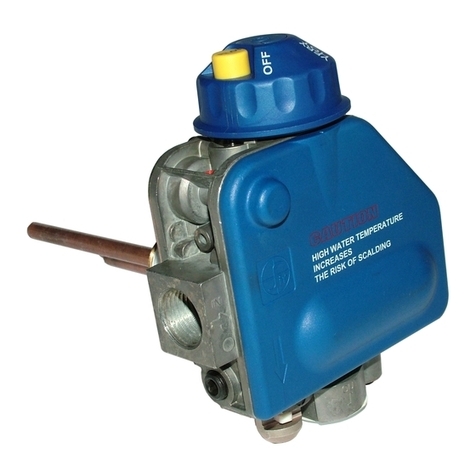
Sit
Sit 650 DELTA Use and Installation Instructions

Grundfos
Grundfos CIM 1 Series Installation and operating instructions
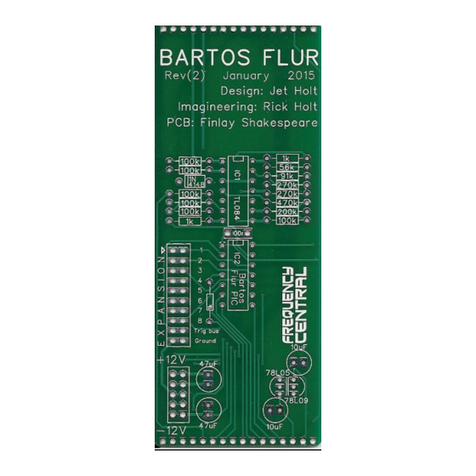
Frequency Central
Frequency Central Bartos Flur Rev(2) Build documentation

MALA GeoScience
MALA GeoScience RAMAC X3M Hardware manual
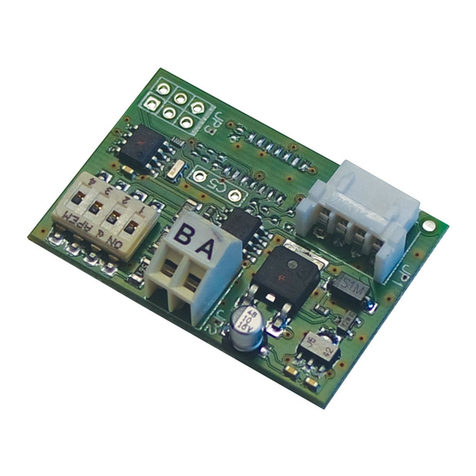
BFT
BFT B EBA RS 485 LINK installation manual
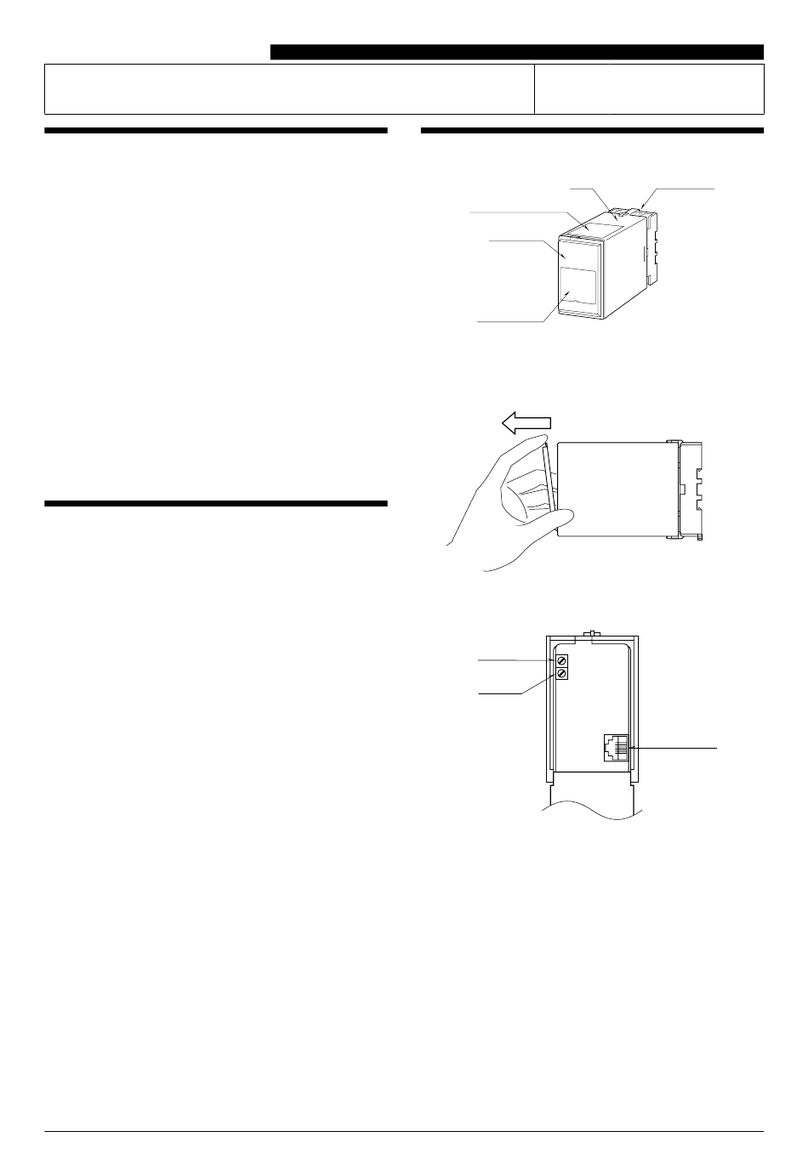
MG
MG JFK instruction manual
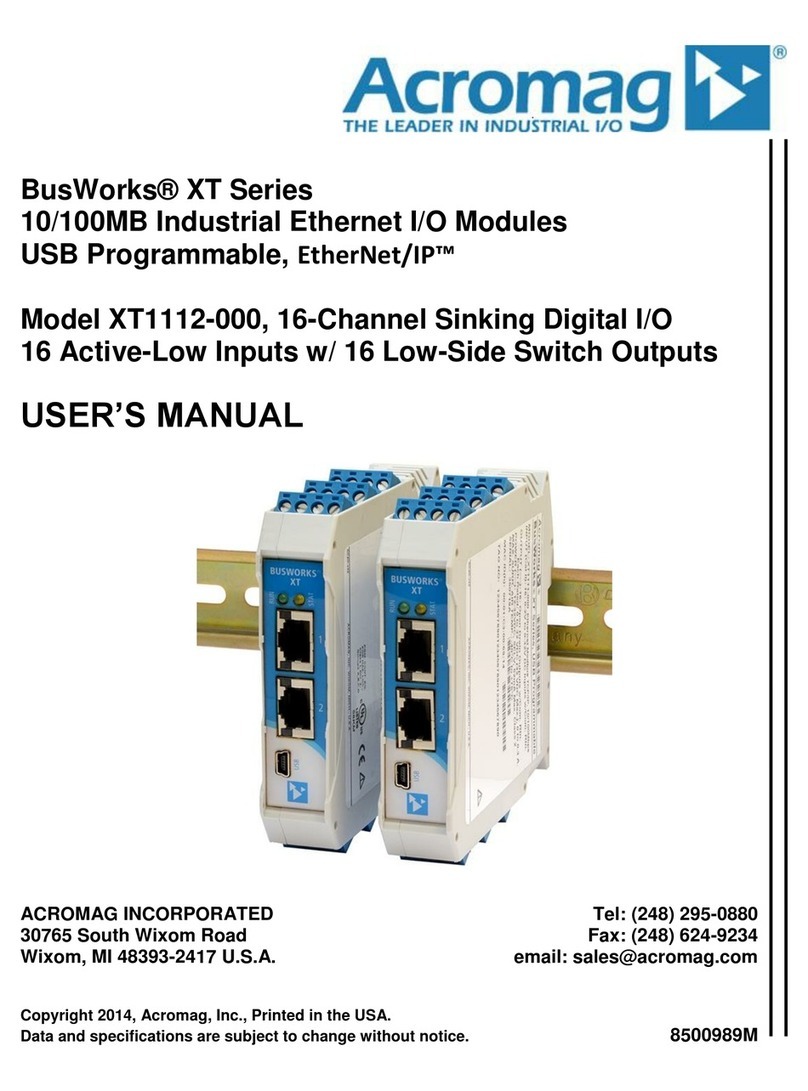
Acromag
Acromag BusWorks XT Series user manual
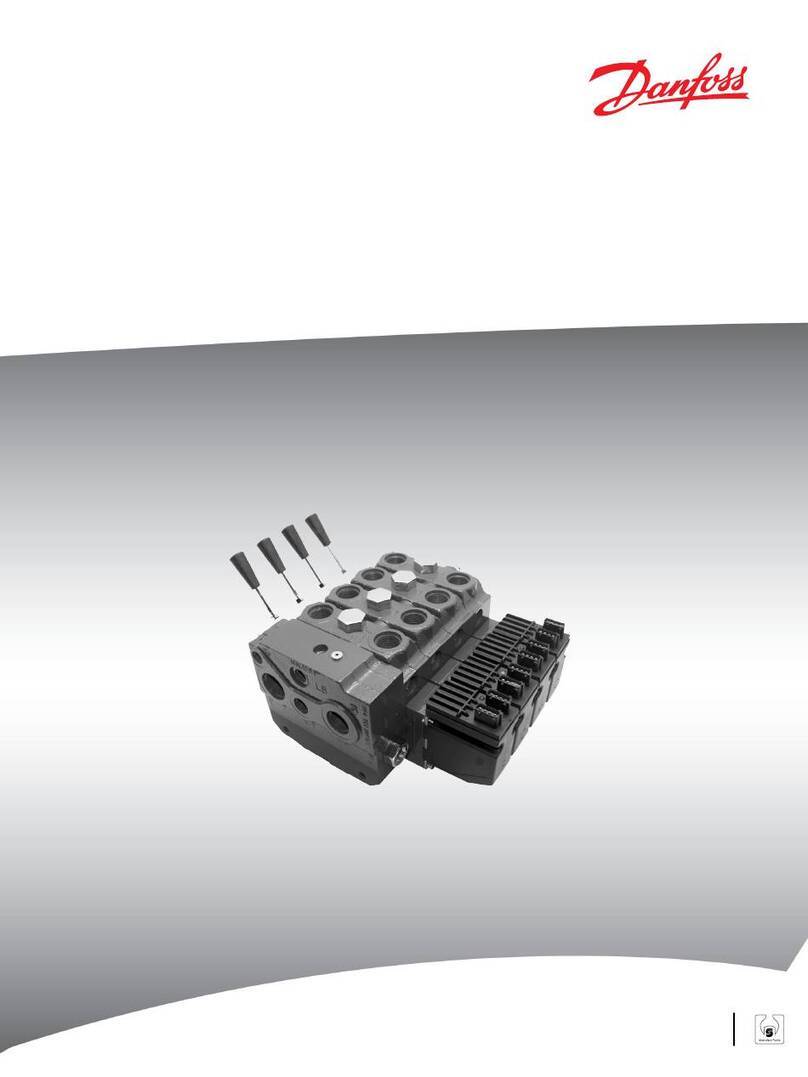
Danfoss
Danfoss PVG 100 Service manual
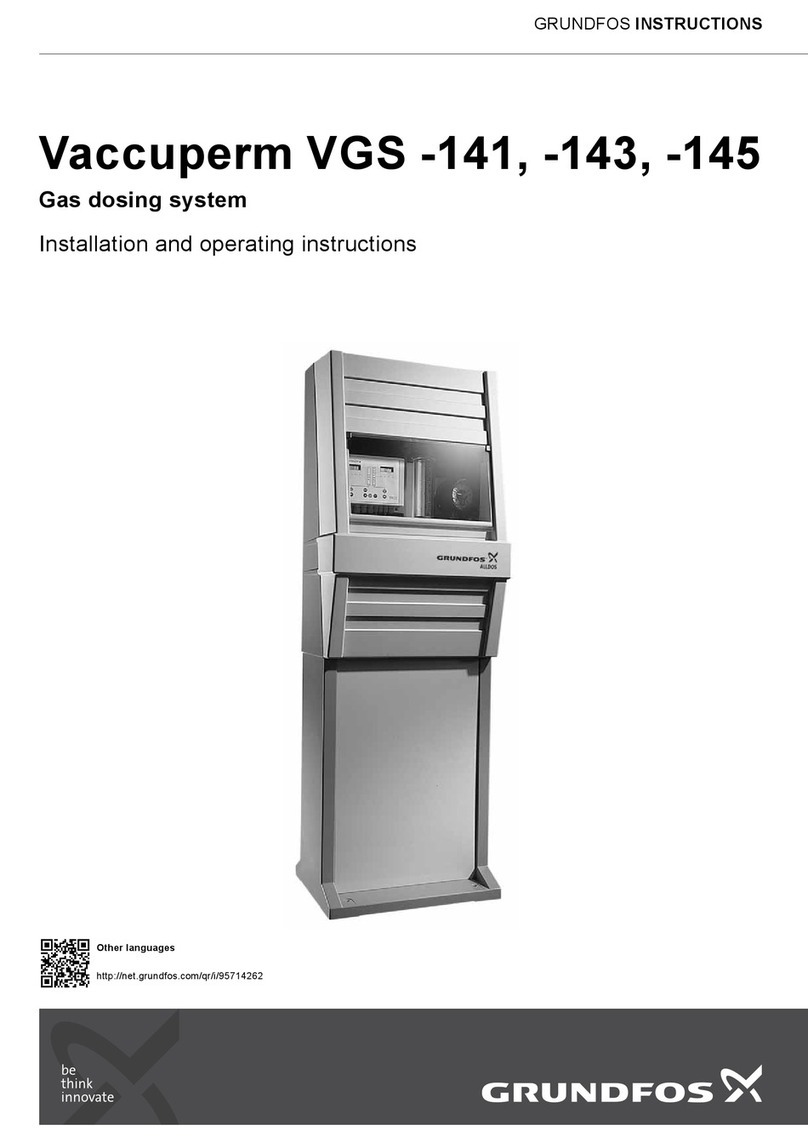
Grundfos
Grundfos Vaccuperm VGS -141 Installation and operating instructions
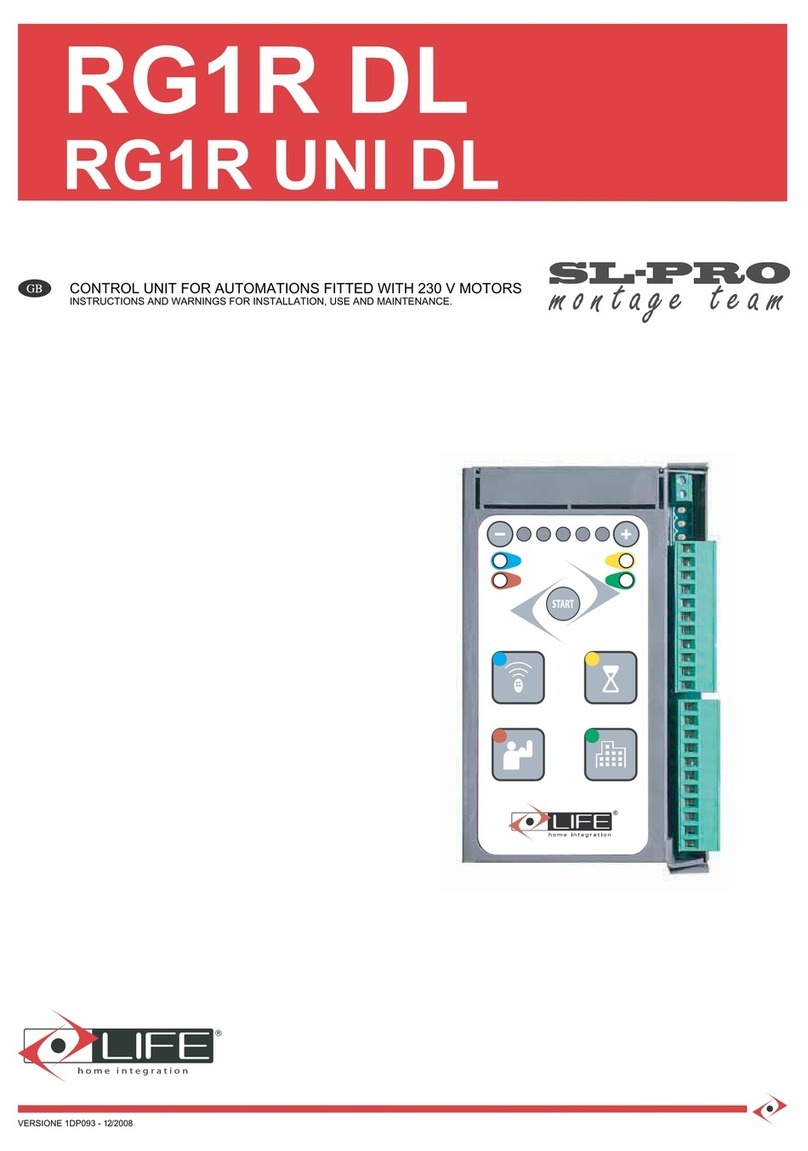
LIFE home integration
LIFE home integration ACER RG1R UNI DL Instructions and warnings for installation, use and maintenance
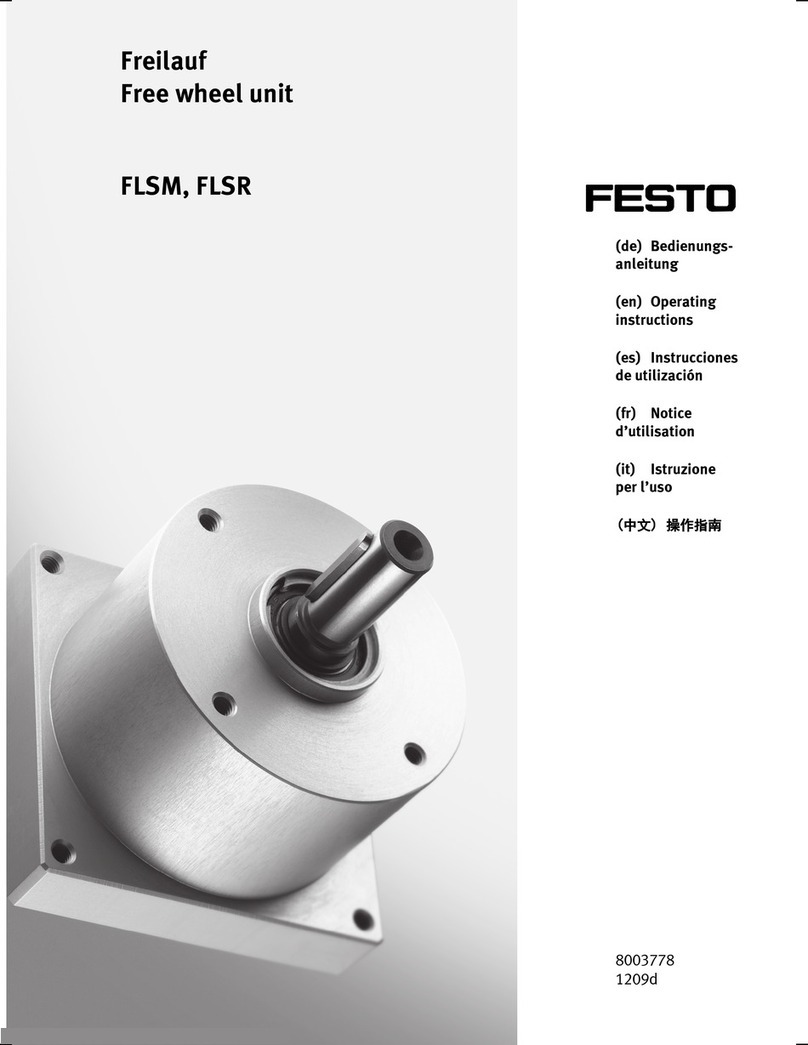
Festo
Festo FLSM operating instructions
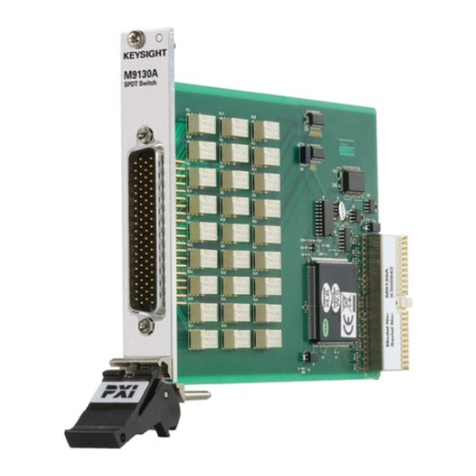
Keysight
Keysight M9131A Startup guide
